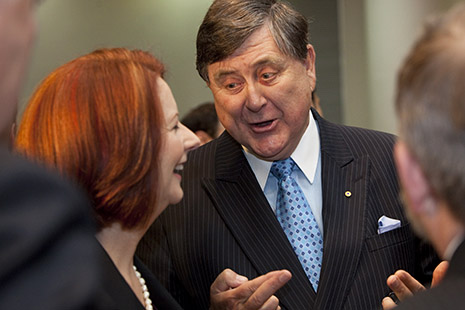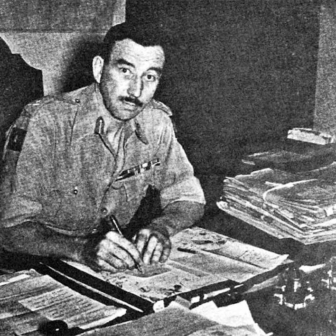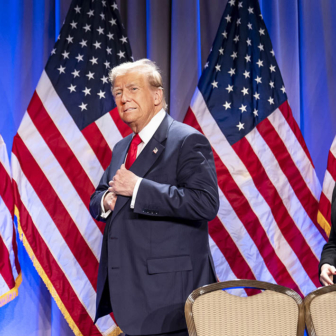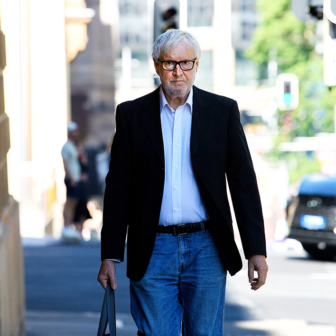Independent Review of the Intelligence Community
By Robert Cornall and Rufus Black
Prime Minister’s Department
Top Secret America: The Rise of the New American Security State
By Dana Priest and William M. Arkin
Little, Brown and Company | $45
COME for a stroll through the parliamentary triangle of Canberra to see how the 9/11 decade transformed the role and riches of the national security community and built new bureaucratic castles.
The walk starts in front of a memorial, simple yet telling, in a secluded corner across the road from the entrance to the House of Representatives. It bears the names of ninety-one Australian citizens and residents who died in Bali in October 2002. As much as the 9/11 attack, the Bali bombings set Canberra’s course for the subsequent decade and the dramatic expansion of the intelligence agencies.
Leaving the memorial and walking down Kings Avenue reveals how expanding institutions always mark their rise with bricks, concrete and marble. The first stop is the new headquarters of that nominal brain of the intelligence octopus, the Office of National Assessments. This is the first time ONA has had its own building – previously it was a sub-tenant of ASIO, the Australian Security Intelligence Organisation, in the Russell complex at the other end of Kings Avenue.
It’s only six months since ONA moved into this refurbished heritage building, renamed to honour Justice Robert Hope, the man who designed Australia’s intelligence structure and defined the formal divisions that drive it today. It’s a tribute to Hope that his two reports (in 1977 and 1984) prescribed what are still the institutional architecture, the official language and many of the assumptions of Australian intelligence. Or perhaps it merely marks the way the secret world protects its own institutions. The intelligence community has had remarkable organisational stability, even structural stasis, while enjoying an extraordinary decade of growth.
Walk another minute down Kings Avenue to the new HQ of the Australian Federal Police, freshly installed behind the bollards and barriers around the Edmund Barton building (previously the home to agencies such as trade, agriculture and environment). Along the way, you’ll notice how the 9/11 decade caused a mushrooming of concrete barriers around Canberra’s public buildings, pushing out perimeters; since Bali, this is a bomb-conscious city.
The shift of the AFP from its old central office across the lake in Civic to the parliamentary triangle is a mark of the way its role and resources surged because of Bali. Although it is not formally enrolled as part of the intelligence community, the AFP is now a key player. Coppers and spooks are defined by their differences as much as their similarities; during the decade, those tensions erupted in some spectacular turf wars between the AFP and the big beast in the intelligence community, ASIO.
Continue on across Kings Avenue bridge towards the longstanding Defence Department complex on the hill at Russell. Defence didn’t need to add any new buildings to its collection to underline its central place in the Canberra universe; the more important achievement for defence workers was to expand the number of car parking spaces.
Then, to see the undoubted winner in the edifice stakes, walk alongside Lake Burley Griffin until you reach a tiny 150-year-old building, Blundell’s Cottage. You’ll need no instruction to lift your gaze from the stone cottage to the giant structure that arcs behind it, the biggest and most expensive construction project in Canberra since the new parliament building was completed in 1988.
Cast your eyes over ASIO’s new central office, big enough for 1800 people, the largest monument to what the 9/11 decade did to Canberra. The new office can still be defined as part of the parliamentary triangle – a geographic zone that is home to the institutions with true power in the national capital – and depending on the way the symbolism is worked, ASIO’s staff will stare across the lake at the High Court or lift their eyes to the giant flag that flies above Parliament House.
All these new offices tell a story of expense and expansion. In 2000, the combined budget of the six agencies in the intelligence community was $325 million; by 2010, the figure was $1070 million. The system has blossomed. The six bodies that style themselves the Australian Intelligence Community are:
ASIO, the spooks who catch spies and terrorists, fighting foreign interference and internal threats.
ASIS (Australian Secret Intelligence Service), the spies who operate beyond Australia’s borders; established in 1952, its existence was not made public by government until 1977, on Justice Hope’s recommendation.
The Defence Imagery and Geospatial Organisation, or DIGO, the agency that works with satellites, targets and maps, producing “geospatial intelligence from imagery.”
The Defence Intelligence Organisation, or DIO, the merged intelligence arms of the army, navy and air force since 1970.
The Defence Signals Directorate, or DSD, which intercepts and guards signals, communication, cryptography and computers.
The Office of National Assessments, sitting at the top of the intelligence community, answering directly to the prime minister.
GROWTH like this always demands a reckoning. What were the misses, mistakes, mishaps and muddles during this major injection of cash and people? How well have the agencies worked to protect Australia’s security? Well, the assessment has been done and the public news is all good: Australia is blessed by the balance, efficiency and competence of the intelligence community.
The task of peering into Australia’s secret world was given to Robert Cornall (secretary of the Attorney-General’s Department during the 9/11 decade until he retired in 2008) and Rufus Black (ethicist, management consultant, theologian and Master of Melbourne University’s Ormond College); together, they were the Independent Review of the Intelligence Community. Perhaps Black provided the independence while Cornall looked after the reviewing of his own legal handiwork.
Putting “independent” at the front of the inquiry’s name gives a little reassurance, but the forty-eight pages released to the public in January read like a publicity pamphlet. The review’s public pages say that the “dramatic” growth in spending will call for continued attention to maintain “the culture that sustains the balance between security and liberty.” But Cornall and Black affirm that Australia got the balance right in the 9/11 decade with a raft of laws “creating new terrorism offences and conferring new powers – particularly on ASIO and the Australian Federal Police.”
Success is measured this way:
The Australian Intelligence Community has helped keep the Australian homeland safe from terrorist attacks for a decade despite a series of major plots. Those disrupted plots resulted in thirty-eight prosecutions and twenty-two convictions. Other potential plots have not been allowed to develop thanks to more than eighty foreign nationals being prevented from coming to Australia on security grounds and more than fifty Australians being denied the opportunity to travel to train for, support or participate in, terrorist activities.
This is one of the few points at which the review gives some evidence for its assertions (although nothing is offered to prove that any of those twenty-two convictions relied on the new anti-terrorist powers). The reason the inquiry gives for withholding the evidence behind its conclusions is almost a classic statement of the circular mentality that so cocoons the secret world: “The Terms of Reference called for a broad investigation into many highly classified or sensitive areas of the agencies’ operations and resulted in detailed recommendations, which cannot be made public.”
With that gap at the heart of what has been released, the two men go on to declare that Australia’s investment in building up the intelligence agencies has been “justified and rewarded with more capability and increased performance.” The intelligence agencies are working well together, they say, and are “beginning to work more effectively with the other members of the recently expanded National Security Community. This evolution will take time – as is the case with any requirement for a significant shift in corporate behaviour...”
A translation of that reference to working together and corporate culture might be: ASIO and the AFP seem to be talking, despite the odd spectacular stoush. In the failed 2007 prosecution of Sydney medical student Izhar Ul-Haque, the judge threw out the AFP case because of the pressure applied to the student by ASIO interviewers. Later, roles were reversed when the AFP detained Mohamed Haneef while it strained to find a terrorist link between the Brisbane doctor and his cousins involved in bombings in Britain, despite repeated advice from ASIO that the doctor was innocent.
Cornall and Black found that management was better attuned to chanting the “altogether now” mantra than were the worker bees, who were more concerned with tending to their traditional patches. Working relationships at the leadership level across the agencies are described as “particularly strong” while at lower levels “some issues remain.”
Look beneath the reassurance to find the gaps and the bumps hinted at by the review. Even as the report finds the existing structure is working well, it repeatedly tells the story of change and agencies that have “evolved substantially.” This means that some contradictions peep out from beneath the confidence that the balance is right and that “there is no need to consider any significant restructure of the existing agencies.” The structure bequeathed by Hope still does the job, even as Cornall and Black see a world in which the threats keep shifting.
JUSTICE Hope’s central logic was a firm division between the agencies that collect intelligence and those that assess it, to “avoid the dangers of a large, all-embracing central secret intelligence organisation.” The Hope structure – embraced and re-endorsed by the new review – sees ASIS, DIGO and DSD as collection agencies, with ONA and DIO doing the assessment. Only ASIO is to have both collection and assessment roles.
Reality is eating away at this neat division. The demand to work together is directed at linking up the silos of the separate agencies. The embrace of the self-created concept of the Australian Intelligence Community is an attempt to talk away differences. The positive view is that this reflects collegiate cooperation; the negative description turns to concepts such as groupthink and a dangerous lack of contestability about the conclusions reached by the Community.
While the intelligence structure created in the 1970s endures, consider how the world has repeatedly changed. Astounded by the end of the Cold War (and a victory, at that), the intelligence types had a slow decade in which their relevance faded. The galvanising moment came with the attacks on New York and Washington, and soon the Bali bombings marked the arrival of the threat on Australia’s doorstep. In fact, Bali delivered more than a dreadful shock; it left a deep sense of both failure and apprehension.
After Bali, the belief took hold that an attack on Australian soil was just a matter of time: not if, but when. That fear lingers. Cornall and Black speak of “inevitable” terrorist shocks. This is our version of America’s Yellow Alert syndrome – a seemingly permanent state of warning about the risk of terrorist attack.
The Australian notion of who will deliver that hit, though, has evolved significantly. Initially, the enemy was foreign, produced and directed by al Qaeda and affiliates such as Jemaah Islamiyah in Southeast Asia. As the decade wore on, though, the face of the enemy changed. No longer was the threat external; now, it was home-grown. The foe could live next door. The dark realisation was that Australia was growing its own potential terrorists, as likely to radicalise themselves as to be formally directed by some foreign force. The Australian intelligence and security system grew in response to a shifting understanding of the terrorist danger. Perhaps the future was becoming clear.
No such luck. By the time the second decade of the twenty-first century arrived, the attacks were frequent – but from cyberspace, not terrorists. Cyber attacks have joined terrorism at the top of Australia’s security threat list – the dire new duo of globalisation.
For the Australian Defence Department, cyber attack is the assault that happens many times a day: 200 a month in 2009, 700 a month in 2010. This is the Australian end of what has driven a deep rethink of the concept of security and seen the United States create a distinct new domain of warfare. The Mario Brothers are off to war. Recruits must be able to stare at screens for hours and possess dancing fingers and dexterous thumbs. The Australian signals intelligence alliance with the United States and Britain, which grew so important in the Cold War, is being reworked.
In what amounts to a bit of Canberra happenstance, ASIO’s new HQ is across the road from the Defence Signals Directorate. The neighbourliness will be useful in what has quickly emerged as a common sphere of concern. Not so long ago, DSD (signals nerds peering overseas) was the silo that was the greatest distance from ASIO’s patch (domestic spooking). Suddenly, they are both trying to navigate a new domain. DSD is the best example of how the Hope dichotomy – strict separation between collection and assessment – is breaking down. In the cyber domain, DSD has to collect, assess, protect and fight.
Add to this the oldest intelligence concern of all – a clash of great powers. Geopolitics is back. Australia is doing a lot of thinking about a country with a name that starts with C and ends with a, and it’s not Cuba. This coyness is reflected by Cornall and Black. The public version of their review can’t utter the word China. Instead, the “new era for intelligence” is being delivered by “the dawning of the Asia Century.” Navigating in a world adjusting to the “impact and importance” of emerging world powers will be “one of Australia’s greatest strategic challenges.” The intelligence community might have to change as much in this decade as it did in the last.
MEANWHILE, the cyber domain is drawing Australia closer to the United States in the same way that the 9/11 decade drew Australia deeper into the American orbit. Although our intelligence community is a micro-organism compared to the gigantic American system, the alliance influences much that Australia does, and often the way it is done. And this means that recent developments within the American security state offer all sorts of insights into what Australia is doing now and the challenges it faces.
The idea of the security state is at the core of Dana Priest and William Arkin’s book Top Secret America, in which these two Washington Post writers provide an outsider version of what Cornall and Black did from the inside. Australia turns up just once in the book, in a discussion of the CIA’s intimate relationships with some foreign agencies. These intelligence links are so strong and important they are seen as able to survive political differences, mishaps or publicity:
The relationship between the CIA and its partners is actually much firmer than the headlines would have readers believe. And for a handful of countries, such as Britain, Australia, Canada, Germany, Jordan, Poland, France and Saudi Arabia, the relationship with the CIA is steadfast. Even when relations go haywire in public, deep in the sock drawer, business remains brisk. This is a function of common interests.
What gets a country deep into the inner drawer with the CIA? Poland wants an alliance to guard against Russian influence, and in return gets help and finance for a Polish commando force “allowed to do things Americans could not.” Jordan provides undercover agents “who participated in snatching terrorists from around the world.” Britain is able to destroy terrorist websites without going through the legal process demanded of US agencies. Priest and Arkin don’t speculate about how Australia got on the list, but having done duty for more than forty years hosting the CIA-operated Pine Gap, one of the largest satellite ground stations in the world, perhaps Canberra is seen simply as a rusted-on ally.
Priest and Arkin map a decade of extraordinary growth within and beyond the sixteen agencies of the US intelligence community, a decade in which the community became an “overgrown jungle of top secret organisations.” The United States has built so “gigantic” a counterterrorism apparatus – the authors’ Top Secret America – that it is now possible to speak of a US terrorism–industrial complex in the same league as the military–industrial complex. Some 850,000 Americans now have top secret clearances, 250,000 of them contractors; around 1200 government organisations and nearly 2000 companies work on top secret programs involving counterterrorism, homeland security and intelligence; agencies and companies do top secret work at 10,000 locations across the United States; and Top Secret America churns out 50,000 intelligence reports a year, “a volume so large that many are routinely ignored.”
Because of the “exponential growth and ever-widening circle of secrecy,” this collection of agencies has became “inert under its own weight and size.” And, write Priest and Arkin, one of the greatest secrets of all is the system’s “disturbing dysfunction.” They track the development of “stress duress” interrogation techniques; the use of the drones that have revolutionised warfare and upped the temptation and the tempo of targeted assassinations; the evolution of the Joint Special Operations Command, which has become “the president’s personal weapon against terrorists” and ultimately killed Osama bin Laden; and the way that war, intelligence and security are increasingly run by contractors and corporations, employed by the US government and military.
The “unrestricted flow of private industry into Top Secret America” has made security more expensive. Contractors make up 29 per cent of the workforce in US intelligence agencies but cost nearly half of the personnel budgets. Defence contractors cost 25 per cent more than federal employees. Contractors work in every US intelligence and counterinsurgency agency. “What started as a clever temporary fix has turned into a dependency that calls into question whether the federal government is still even able to stand on its own.”
Only God has a clear understanding of what happens in every secret compartment of the US system, Priest and Arkin write; no one else would have the time or capability, even if they could get clearance to see all those secrets. The “poor quality of congressional oversight” gives little confidence that the politicians have much control, while “the government has fallen into the bottomless well of official secrets.”
As part of a solution, the two reporters argue that no material should be classified top secret unless it truly meets the official definition of what top secret means: public disclosure would cause “exceptionally grave harm” to national security. WikiLeaks has just conducted an uncontrolled experiment that suggests making enormous amounts of classified material public doesn’t actually cause grave harm; Priest and Arkin argue that the experience of the last decade shows that breaching the wall of secrecy seldom produces damage:
Despite all the unauthorised disclosures of classified information and programs in scores of articles since September 11, 2001, our military and intelligence sources cannot think of any instance in which security has been seriously damaged by the release of information. On the contrary, much harm has been done to the counterterrorism effort itself, and to the American economy and US strategic goals, by allowing the government to operate in the dark, by continuing to dole out taxpayer money to programs that have no value and to employees, many of them private contractors, who are making no significant contribution to the country’s safety.
The conclusion offered is that only 1 per cent of current top secret information deserves the classification. The US government should have its own WikiLeaks moment. There might be some embarrassments, Priest and Arkin write, but not much in the way of grave harm:
More secret projects, more secret organisations, more secret authorities, more secret decision making, more watchlists, and more databases are not the answer to every problem. In fact, more has become too much. The number of secrets has become so enormous that the people in charge of keeping them can’t possibly succeed.
After the shocks that gave us the 9/11 decade, one of the continuing challenges will be to persuade those inside the secret world – and not just in the United States – that it is safe to give up so much secrecy. •




